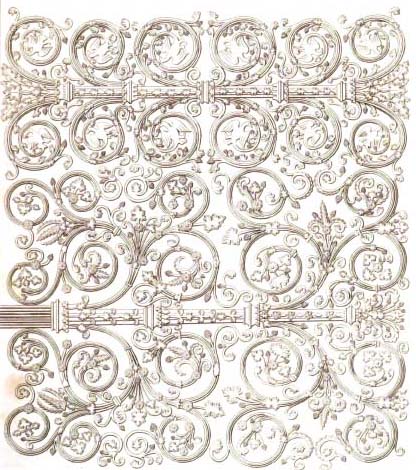Illustration: Embroidered velvet cover of a Bible, 1583.
In many ways embellishment is the ultimate tool of the decorator. It can be seen, with some degree of accuracy, as the heart and soul of the decorative world. To understand and accept embellishment is to understand and accept decoration.
Picking up a dictionary, Collins English, the easy definition of the word embellish is:
to make something more attractive by adding decorations
or
to make a story more interesting by adding details which may not be true
Collins Thesaurus makes an addition to the word embellish by adding: decorate, enhance, adorn, dress, grace, deck, trim, dress up, enrich, garnish, ornament, gild, festoon, bedeck, tart up, beautify.
Illustration: Decorative iron work from the doors of Notre Dame, Paris, 13th century.
To make an addition to, or to enhance the sum of, seems to be an integral part of human nature. We have always felt the need to embroider, using the word in its loosest term, whether that be through design or craft, or indeed through fact or fiction. In this we are as one species, as no matter what culture or era we think of, all used decoration to enhance and embellish most elements of the artificial world that they created around them.
Textiles in particular has a long and full tradition of embellishment. Additions to fabric can take the form of nearly anything, from the addition of pure stitching to other fabrics, beads, metals, wood, glass, precious stones, animal products, and so on.
Embellishment can also take many forms, with pattern work following the suggestion of nature, the geometrical abstract, fonts and lettering. It can be perceived as a subtlety, the changing of colour, line and texture, or it can be much bolder, using large-scale shapes and patterns. Whatever the technique or suggestion for composition, the end result is always nearly the same, to make something more than it was, to add decoration to enhance its attraction to the individual.
Illustration: Henry William Arrowsmith. Decorative design, 1811.
However, embellishment was by no means limited to textiles. Ceramics, glass, metal, wood in fact all the major and minor decorative arts used embellishment as a legitimate tool in which to decoratively enhance their results and it was seen by generation after generation as an integral addition to the skills base of the discipline, rather than as a filler or by-product of the main event.
This relatively intense and symbiotic human attraction to the decorative is something that Modernism, on the whole, failed to take into account. In many respects, Modernism saw one of its tasks as the declaring of war on the traditions of human nature and human decorative art, seeing decoration and pattern as the addition of extraneous embellishment through dishonesty to the form and function of the product. To be fair this does have some merit, embellishment can well be seen as a form of tarting up, a disguise or distraction of the practical purpose of the product if you will, even to the point of the deflection of the truth, anyone who has bought a frozen pizza in a box will know exactly what I mean. Even the second definition of the Collins English dictionary stated above, although being an application towards fiction and story-telling, does make the implication clear as far as at least a proportion of embellishment is concerned: adding details which may not be true.
Illustration: Decorative ornamental detail, 1826.
Having said that, was it strictly necessary to have a near iconoclastic crusade against the world of embellishment, decoration and pattern? Probably not. A number of minimal Modernist enthusiasts had frankly disturbing ideas as to where they stood in the time frame of the decorative arts, compared to those who embellished. Many of those ideas and analogies bordered on cultural bigotry, with traditional decoration being seen by many as belonging to a world of the non-sophisticated and the culturally backward. It is perhaps an unsavoury aspect of some of the twentieth century theories on design and decoration, theories which are often stripped of their more contentious aspects by today's world.
In many respects, the iconoclastic approach the Modernists took to decoration had a mixed result, at least on the level of the removal of pattern. The twentieth century history of textile pattern work is just as rich, if not more so, than the previous nineteenth century. However, embellishment is not quite what it used to be. We have no arabesques or curlicues to embellish our phones, TVs, cars, laptops, building exteriors, pavements. We live in an environment where embellishment is often limited and contained, leaving much of our artificial world often with a stark and plain prospect. In some respects, is it any wonder then that graffiti, apart from the sanctioned graffiti of the advertising world, is often the only outward appearance of colour, intensity and expression, and even this is frowned on as a departure from the norm, in other words an attack on the minimal by the decorative.
Illustration: Transylvanian embroidered woman's winter jacket.
There is always more than one way of looking at things and there are of course merits within the decorative and non-decorative worlds. However, personally I would be more than happy to own a piece of technology that favoured the flamboyant, and would love to walk down a high street that favoured pattern through tessellation, rather than grey flagstones and tarmac. In other words, long live the human capacity for embellishment.
Futher reading links:




